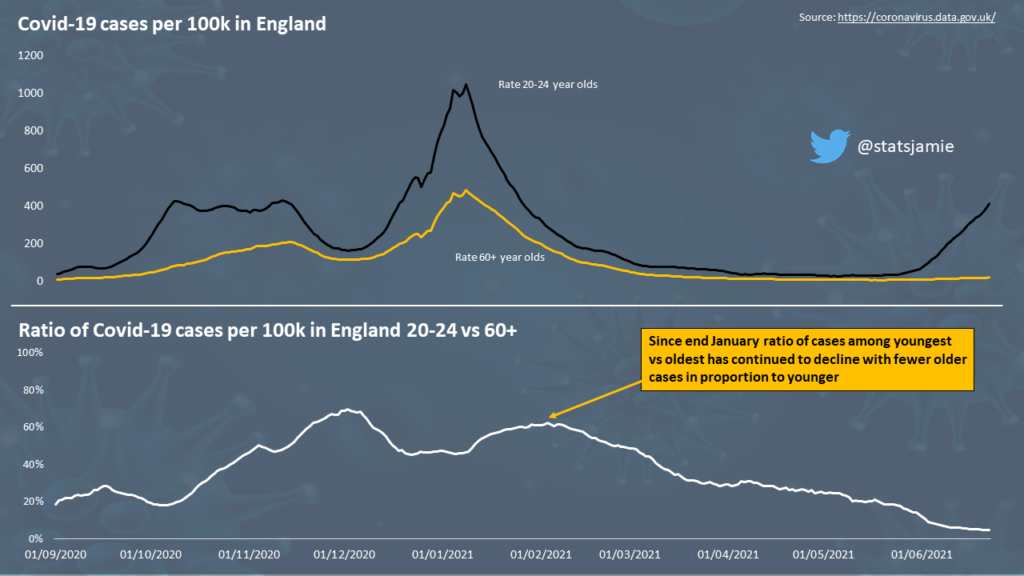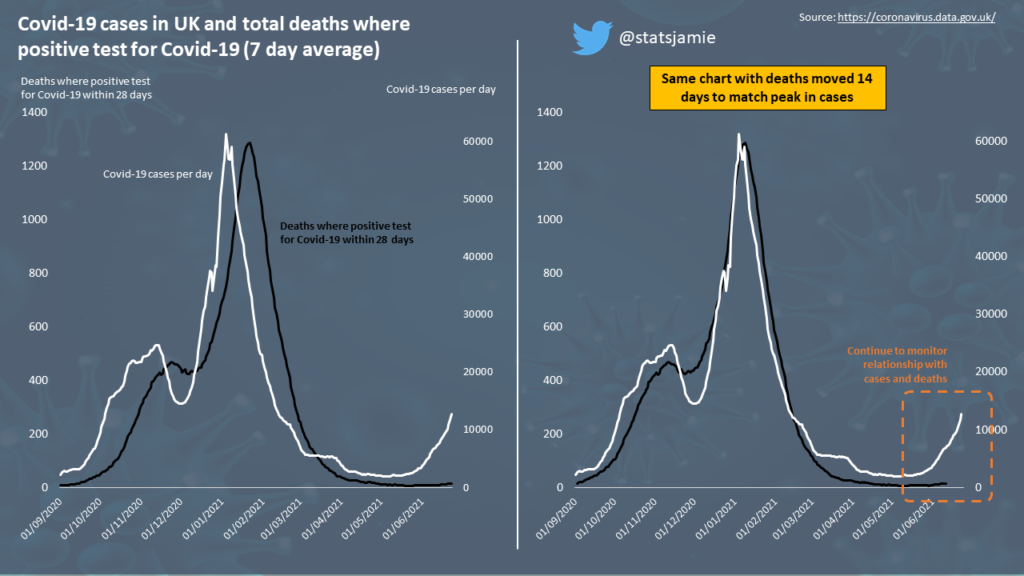In the UK over the past month, we have seen a rise in Covid-19 cases which has sparked worry of a third wave of the virus. How much worry should there be?
The rationale for the national lockdowns last Spring and Winter was to protect the NHS and save lives. At the start of the two waves, there were so few antibodies among the population that lockdown was the default response. As I write, most of the vulnerable have had two doses of a vaccine, thousands more have recovered from Covid-19, and the vaccine rollout continues at pace.
Deaths concentrated among older but the recent case rises among younger
93% of the deaths where Covid-19 was mentioned on the death certificate are among people aged 60 and over. If we track the recent Covid-19 case rises the biggest driver is people aged 20 to 24. I have looked at the rate for this age group compared to people aged 60 and over and there has been little change in the rate for older people (shown by the yellow line on the graph below).

The ratio of cases among the old and young have been falling in recent months – meaning fewer cases in the old relative to the young. This is important because we know an infection of an older person is significantly more likely to be deadly.
A plot of cases (left-hand axis) and deaths (right-hand axis) shows the latter peak around 14 days after the peak in cases. Aligning the two peaks, you would expect to start seeing a rise in deaths now in the UK if the same pattern of before continues. With cases among older people not rising significantly, and many having antibodies, it would surprise me if there was a surge. Public Health England analysis suggests that vaccines are highly effective against hospitalisation from the new Delta (Indian) variant. The next few weeks will be important for a definitive answer on the relationship between cases and deaths – which does appear to have broken.

Living with Covid-19 risk alongside other factors that cause harm
I have previously written we need to live with a level of Covid-19 risk and the deaths that comes with it. The most recent figures from the Office for National Statistics show there were over 1,163 deaths registered in England and Wales in the week ending 11 June 2021, where pneumonia or flu was mentioned on the death certificate – over 10 times the number where Covid-19 was mentioned (84). Even at the more stringent measure, where pneumonia or flu caused the death, and not mentioned as just a factor, total deaths were over 4 times higher than for Covid-19.
We do not issue daily updates on how many deaths where there were positive tests for pneumonia or flu. For the most recent 7-day period there were 14 deaths reported where there was a positive test for Covid-19. While each death is a tragedy for each family, what this metric does not tell you is if Covid-19 was a key reason for the death.
Total deaths continue below average
One measure that helps cut through the limitations in the data is looking at the total number of deaths in the country compared to the average level for the time of year. If there are significantly more deaths than average, you know the virus is causing deaths that would not have otherwise happened. Using this metric we know deaths in England and Wales have been below average since March and while people have died with a positive Covid-19 test, many will most likely have died anyway.
The new Health Secretary in England, Sajid Javid has previously overseen the brief at the Treasury along with a previous role overseeing business. His previous roles may bring a wider lens when it comes to considering measures to limit the effect of Covid-19 on public health alongside the wider impact of restrictions.

